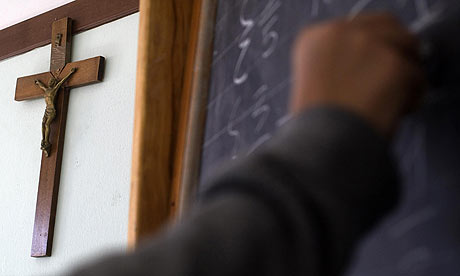RUAIRÍ QUINN’S plan to transfer some 50% of Catholic primary schools to a different model of patronage will prove as fraught with pitfalls as it may be historic.
The minister will have his work cut out if he wants to even partially realise his vision during the lifetime of this Dáil.
Everyone agrees there are too many Catholic schools to meet current demands.
Dublin‘s Archbishop Diarmuid Martin was one of the first people to raise the issue calling for a forum on future patronage.
His call was largely ignored by the last government.
Mr Quinn this week launched such a forum, which he has asked to report as a matter of urgency.
The current national-school model was introduced under British rule in 1831 and was intended to be multi-denominational.
The plan was initially fiercely resisted by the Catholic hierarchy, which sought the right of Catholic parents to choose a Catholic education.
Archbishop John MacHale of Tuam — known as the Lion of the West — feared the system was designed to weaken the faith of Irish children and usher in Protestant proselytism through the back door.
However, the fact that the population was overwhelmingly Catholic ensured that most schools were de facto Catholic.
Today, the local Catholic bishop is patron of some 90% of primary schools and in charge of appointing teachers and setting the ethos of the school.
That figure has remained substantially unchanged despite significant demographic shifts.
The data from Census 2006 shows that the number of people identifying as non-religious is now at 186,318, up from just 1,107 in 1961 and up a third since 2001.
This figure will certainly increase further — possibly at a much higher rate — when this month’s census returns are available.
At the same time Islam is set to top more than 50,000 adherents in this latest census while other minority religions are increasingly dramatically.
That being said, the Catholic community remains a significant bloc. Some 87% of Irish people self-identify as Catholic, and even allowing for lower practise rates about 46% of Catholics attend Mass weekly, with the figure rising to almost 60% on a monthly basis.
Based on these figures Mr Quinn’s ambition of half of Catholic schools changing hands seems optimistic, at least in the short-term.
The Catholic hierarchy, largely spurred on by Archbishop Martin’s experience of some Catholic schools in his own diocese, where Catholics are in the minority, is in favour of at least some divestment.
But tensions are already emerging and the gulf between Dublin and other dioceses may well widen.
Bishop Leo O’Reilly, whose Kilmore Diocese covers largely rural Cavan and Leitrim, recently said: "I can understand Archbishop Martin’s concern around patronage being in a very large urban setting where in some schools there would be a small minority of children from families who practise the Faith. It’s somewhat different in other areas "where the majority of students would still be from families where the faith is practised regularly".
Tellingly, the Catholic Communications Office was unable to provide a spokesman to discuss the issue on RTÉ’s Morning Ireland last week, indicating that a common Church policy may still be some way off.
Even where Church leaders are keen to press ahead quickly with divestment they are sure to face local resistance in at least some areas.
Where a transfer is proposed how will local views be ascertained?
If a local vote is taken and is, say, split 60%-40% in favour of divestment, will the 40 opposed have to move their children to remaining Catholic schools in neighbouring parishes?
The situation may be easier in a parish where there are several Catholic schools.
But what about where there is only one local school?
Church leaders privately admit that they want to retain a scenario where every parish in the country continues to have at least one Catholic school.
Property rights will also emerge as an issue.
At present, local Catholic schools are owned by the parish priest and are leased on a long-term basis by the state.
If a school merges with another nearby school, thus vacating the building, the state expects the local parish to reimburse the exchequer for the outstanding years of the lease already paid.
Given the Constitution’s strong emphasis on the right to private property the Supreme Court is likely to strike down any deal that would see the state take over parish property without compensation at market value.
Schools are also government by very strict criteria laid down by the Charity Commissioners on what they can and can’t do with property that becomes surplus to requirement.
What will become of schoolteachers in schools due to be transferred to a different patron but who oppose the move?
Will they be forced to transfer to another school?
One can almost hear solicitors sharpening their pencils already in anticipation of the steady procession to the Employment Appeals Tribunal.
So, when the forum inevitably reports that there are too many Catholic schools to meet current demand changing that situation — headaches and all — will be a long way off.
- Michael Kelly is Deputy Editor of The Irish Catholic.






No comments:
Post a Comment